Problems of modern robotics 2, or how games will save the world ...
In this post I have already told you how I see the situation that has developed in the area that should have been a mass phenomenon for a long time, but this did not happen. Household robots have not become, somehow a natural product for at least some significant part of the population of the planet.
In the comments, people expressed their assumptions about the reasons for this situation, and someone suggested ideas on how to fix this.
Well, as an engineer, I could not get past this situation and offer my own “method” to solve this problem ... Real WarBots (yes, hello at the same time, we are Cygob)
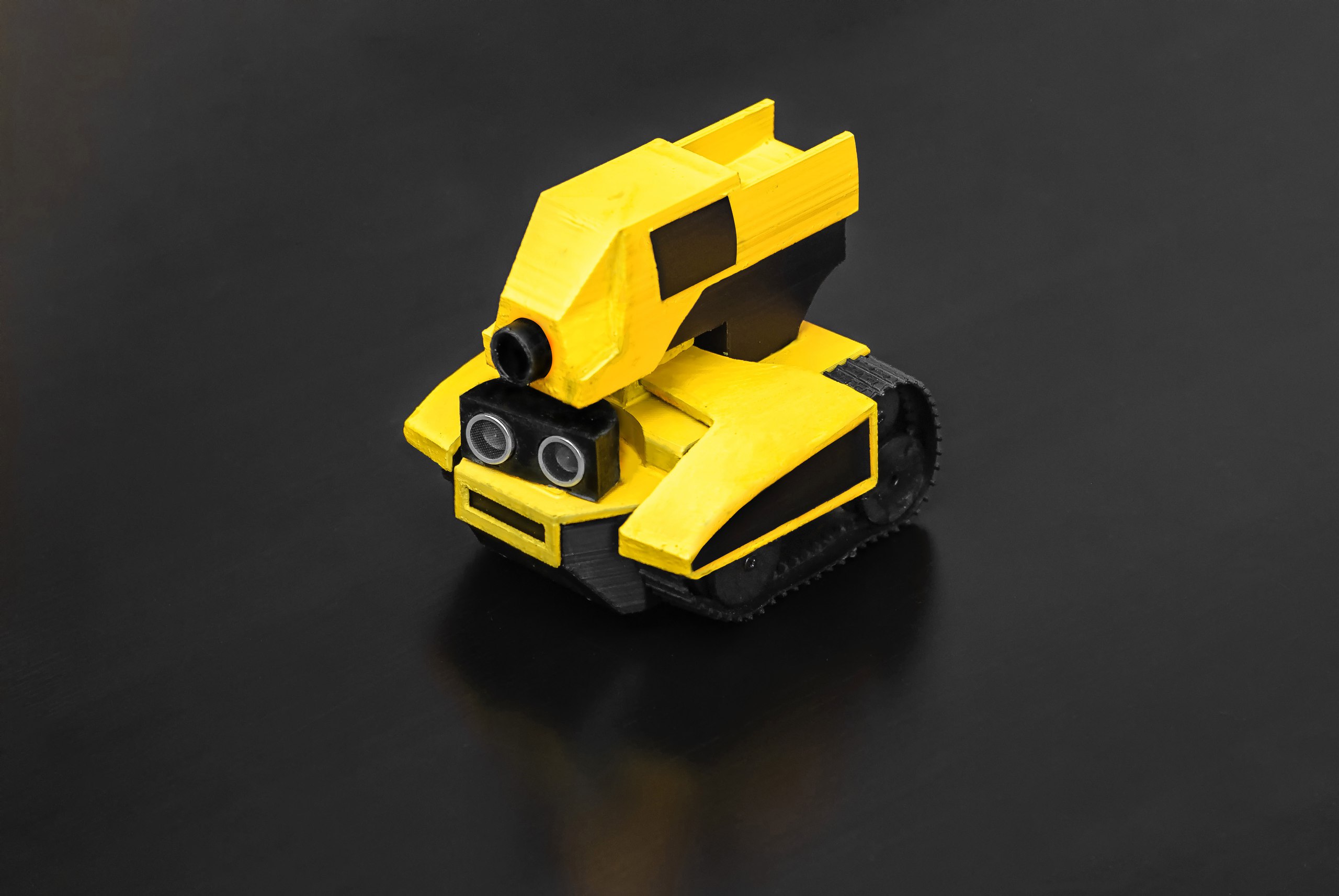
But back to 30+ years ago, when about the same problem was in personal computers.
')
Indeed, at one time, computers were also very expensive thing with a controversial utility. There were even statements like “Computers for ordinary people are not needed” ...
But now there are computers, almost in every home. But how did they become popular? As I see "guilty" in this entertainment, and of games in particular. For such is human psychology, all that adds fun invariably attracts attention.
Whether these were students coming into the department and hacked into Castle Wolfenstein or much later I was young when I saw the first Fallout, everyone always wanted to get the same at home. Well, sooner or later received.
And now, in many ways, the engine of progress of computer hardware, these are just games. Because office employees do not need cool iron, and 3D modelers and other specific professionals are simply too few.
So, having received these theses, we applied them to robotics.
So, I present to you the Real WarBots.
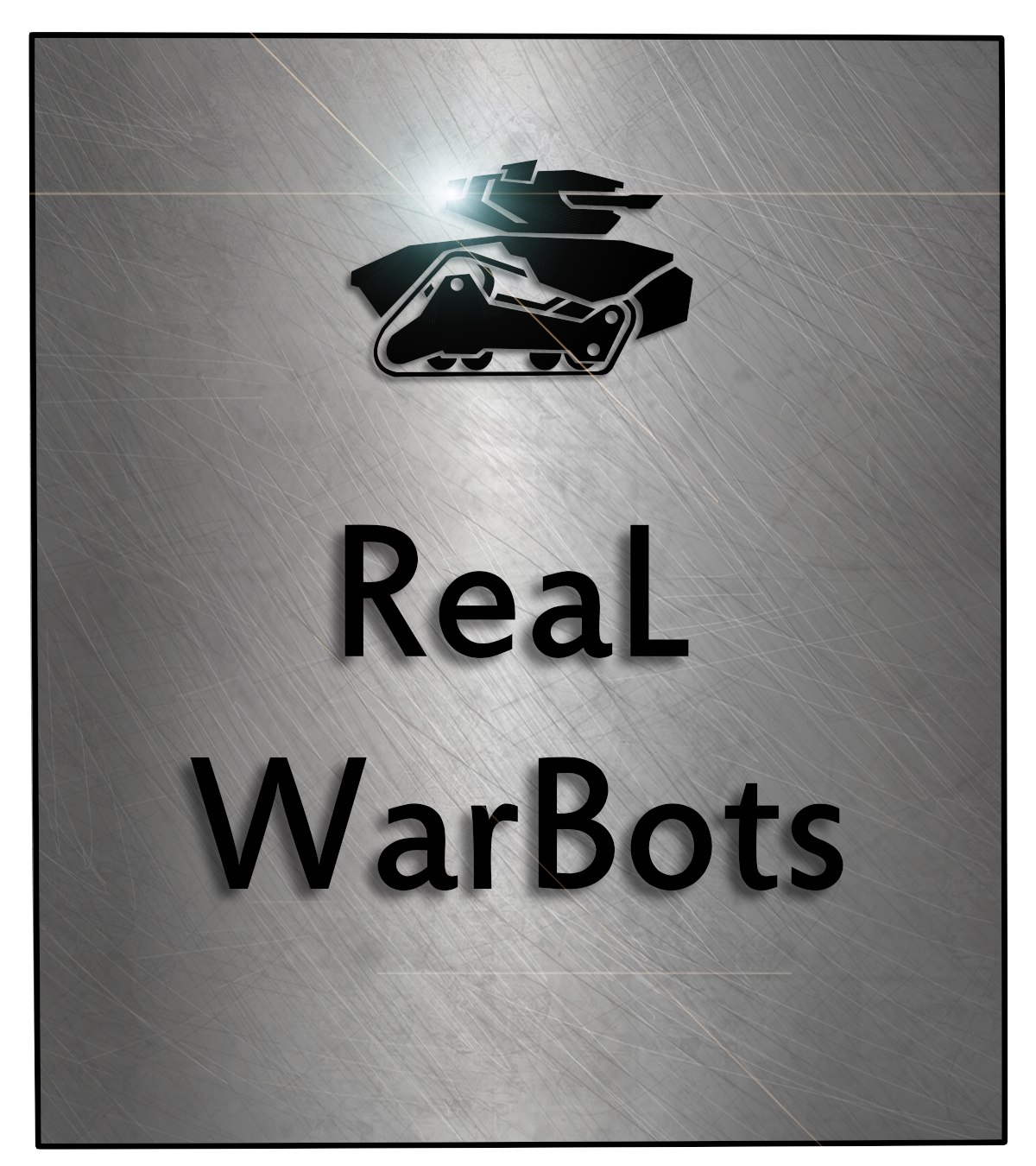
Real WarBots is a strategy game for two or more players, where the battlefield is not computer screens, but rooms in your homes. Real robots will fight, with real shells.
The goals of the game repeat the mechanics of computer strategies in real time. Just like there, the player will have to scout the "map", gather resources, protect the base and destroy the enemy.
However, these are robots, and therefore their management differs from the standard one.
A player in strategic games constantly, consciously or not, collects in his head a kind of "action algorithm". Something like: "these troops should go here, this detachment distracts the enemy here, and at this time we collect resources from here."
Approximately the same thing we introduce in the direct control of robots. The player must assemble an algorithm of actions for the robot from the simplest blocks, each of which is responsible for some particular action - shooting, movement, turns, and the like. After that, the algorithm is sent wirelessly to the robot, and the robot begins to perform its task. And if the situation on the battlefield changes, the player creates a new algorithm, sends him to the robot and he begins to act in a new way. Such management allows you to operate a large number of robots, the battle between a couple of dozen machines is not a problem, of course, if they exist.

The player is free to make algorithms of varying complexity. Someone will collect their many and unpretentious, created literally in a couple of clicks, and constantly send new tasks to the robots, which will give the player the opportunity to quickly respond to the situation. Peculiar micromanagement.
The other player will sit for a while before the game, and compose a huge non-linear algorithm consisting of thousands of blocks with cycles and conditions, in fact create a kind of simplified artificial intelligence, while at the game itself, by loading it into robots, drinking tea will watch for nothing understandable opponent who loses his troops.
Well, or not, if somewhere is mistaken or miscalculated, and he himself will be hard to look for a way out of the situation.
The transfer of the algorithm to the robot is not instantaneous. There is a slight delay between the transfer of the algorithm and the start of its execution.
On the one hand, this ensures the impossibility of direct control of the robots and forces players to think through their actions beforehand, and on the other, adds tension to the game, because sometimes it is necessary to urgently change or correct the algorithm, and then you have to frantically count seconds before it starts, while fulfills his plan.
To control the robots players are given a software environment.
Conventionally, it can be divided into several zones. The work area where the algorithm is created from different blocks. A map showing what obstacles robots see around them. There is also a list of buttons denoting software blocks and a list of those robots that the player has. Each robot will have its own unique identification number, a part of which will also be displayed in this list. Well, the big send button, which sends the collected algorithm, to the robot that is selected in the list.
Currently she is working on computers, later we will transfer it to iOS / Android
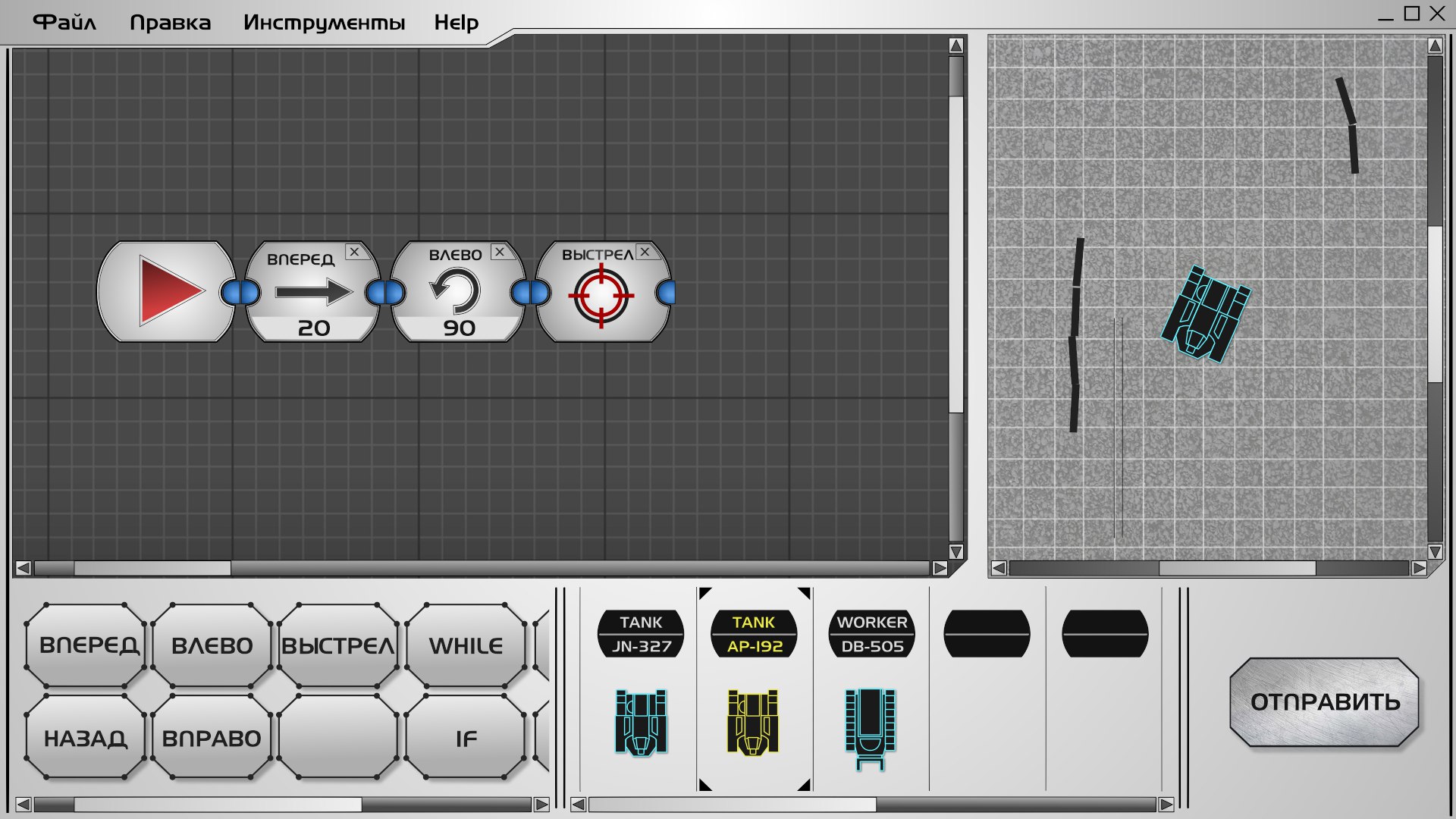
Robots have ultrasonic obstacle sensors and everything they see looms on the map in the player's interface. This allows us to estimate the distance between the robot and the objects surrounding it and set the parameters in the movement blocks not “by eye”, but with a certain accuracy. In addition, it allows to assess whether there are obstacles in the path of the robot where the person himself no longer has the physical ability to see the “landscape”, for example, if the robot drove into a chair or even went to another room.
The ability to play "blind" without adjusting what the sensors of the robot see with what the person sees, will add interest to the game, although it will increase its complexity, which means it is recommended to be done by more experienced players.
In addition, it is obvious that with an increase in the number of robots, and hence the expansion of the size of the room for the game, the number of “blind spots” for a person will increase - areas that his personal vision no longer covers and there will still have to rely entirely on the sensors of robots.
The obstacles on the map, with the exception of other robots, are indicated by simple dashes sufficient to understand that the robot will not pass there. Other robots are designated by their icons in order to distinguish the enemy from, say, the walls.

Desktop wargames have the opportunity to personalize their units. Usually the table figures are decorated, and often the player himself modifies, which means for him this particular “soldier” becomes not just another faceless unit in the army. He has some differences from all the others. And later, if he was able to accomplish something little possible during the game, this particular soldier remains in the player’s memory for a long time. As some kind of story is connected with it, and along with the story, emotions are connected, in general, and attracting people to board games.
So why not add a similar element to our robots?
So. Each robot will have its own identification number, which will be scored immediately “at the factory” and will never change. In fact, each robot will be unique, with its own name.
This will allow to personalize each robot, and to the question “And which of the robots did you make this shot?”, You will no longer answer vaguely, “Well, that one ...”, but you will be able to proudly say, “This is my 313rd, he will never misses! "
The victories of each robot in the official tournaments will be recorded in the Hall of Fame Real WarBots, so that everyone will have the opportunity to compare who is cooler.
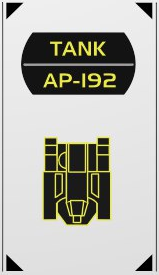
RPG elements are currently present, almost in every first game. This is understandable; it is always fascinating to watch the “pumping” of your troops / characters / buildings.
How can we introduce similar elements to our robots?
Well, firstly the most obvious. A robot tank, when destroying other robots, gains experience points that a player can spend on ... for what? The easiest way is to add life points to the robot. The more hits the tank can withstand, the more useful it will have time to do before life. Then you can reduce the pause time between the receipt of the algorithm by the robot and the beginning of its execution. (Do you remember that the algorithm doesn’t start running immediately?) It is even possible to introduce a “heroic mode” - a mode with direct control of the robot, like with radio-controlled machines ... but this option can break the game.
Further, individual hero robots are possible. On another platform, with a different iron.
There you can already enter the enhanced "pumping". In addition to the standard increase in life points, make the possibility of accelerating the movement of the robot. It is possible to add removable modules, with an increased number of guns, or even a swivel turret. Yes, and the form of the robot can be changed, do not have a tank platform, and the hexapod - a robot with several legs.
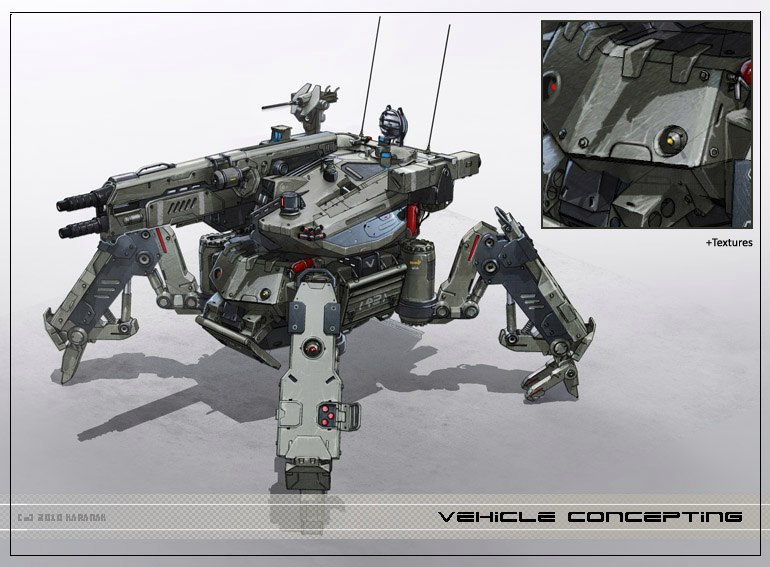
For projects like our important part is the support and development of the gaming community.
To attract the attention of new people, as well as to introduce a sports element for experienced players, tournaments will be organized. The formats of tournaments with time, and based on practice, will certainly expand, but the main modes are already clear: the battle between two players using a small number of robots, and mass battles for several people and a large number of robots at once. The second mode, although demanding of the size of the battlefield, but should be the most spectacular and diverse from a strategic point of view.
In this case, in both of these modes, players will be able to express themselves, as well as in terms of their tactical / strategic talents, and in the ability to create algorithms for robots. At the same time, the element of chance is not going anywhere, because our robots are real, which means that a ricocheted projectile can cross even the seemingly perfect algorithm. Unless a player can take into account such accidents and reduce their influence to a minimum, which again depends on his experience and skill.
It is very important to maintain communication between the players, respectively, a forum will be organized on our website. There, players will be able to share their experiences, ideas for algorithms, negotiate games, etc. And of course, there players will be able to offer their ideas to developers. New robots, new modes, improved game interface, everything that can help make an excellent hobby.
Well, game exhibitions will not be forgotten either, the thing is fun and useful.
Well, we should probably add a video with our robots ... or rather a small excerpt of our future video
In general ... this is our idea, please evaluate.
Our group Vkontakte somewhere here vk.com/realwarbots
Well, yes, in a couple of days we’re getting out on Kickstarter with all of this, so I ask everyone who likes strategies, or who is a robot for robotics, or who simply hates his cat and is looking for new ways to bully him, subscribe to our groups so that skip the launch, and support us with ruble and repost.
In the comments, people expressed their assumptions about the reasons for this situation, and someone suggested ideas on how to fix this.
Well, as an engineer, I could not get past this situation and offer my own “method” to solve this problem ... Real WarBots (yes, hello at the same time, we are Cygob)

But back to 30+ years ago, when about the same problem was in personal computers.
')
Indeed, at one time, computers were also very expensive thing with a controversial utility. There were even statements like “Computers for ordinary people are not needed” ...
But now there are computers, almost in every home. But how did they become popular? As I see "guilty" in this entertainment, and of games in particular. For such is human psychology, all that adds fun invariably attracts attention.
Whether these were students coming into the department and hacked into Castle Wolfenstein or much later I was young when I saw the first Fallout, everyone always wanted to get the same at home. Well, sooner or later received.
And now, in many ways, the engine of progress of computer hardware, these are just games. Because office employees do not need cool iron, and 3D modelers and other specific professionals are simply too few.
So, having received these theses, we applied them to robotics.
So, I present to you the Real WarBots.

Real WarBots is a strategy game for two or more players, where the battlefield is not computer screens, but rooms in your homes. Real robots will fight, with real shells.
The goals of the game repeat the mechanics of computer strategies in real time. Just like there, the player will have to scout the "map", gather resources, protect the base and destroy the enemy.
However, these are robots, and therefore their management differs from the standard one.
A player in strategic games constantly, consciously or not, collects in his head a kind of "action algorithm". Something like: "these troops should go here, this detachment distracts the enemy here, and at this time we collect resources from here."
Approximately the same thing we introduce in the direct control of robots. The player must assemble an algorithm of actions for the robot from the simplest blocks, each of which is responsible for some particular action - shooting, movement, turns, and the like. After that, the algorithm is sent wirelessly to the robot, and the robot begins to perform its task. And if the situation on the battlefield changes, the player creates a new algorithm, sends him to the robot and he begins to act in a new way. Such management allows you to operate a large number of robots, the battle between a couple of dozen machines is not a problem, of course, if they exist.

Algorithm complexity
The player is free to make algorithms of varying complexity. Someone will collect their many and unpretentious, created literally in a couple of clicks, and constantly send new tasks to the robots, which will give the player the opportunity to quickly respond to the situation. Peculiar micromanagement.
The other player will sit for a while before the game, and compose a huge non-linear algorithm consisting of thousands of blocks with cycles and conditions, in fact create a kind of simplified artificial intelligence, while at the game itself, by loading it into robots, drinking tea will watch for nothing understandable opponent who loses his troops.
Well, or not, if somewhere is mistaken or miscalculated, and he himself will be hard to look for a way out of the situation.
Nuances
The transfer of the algorithm to the robot is not instantaneous. There is a slight delay between the transfer of the algorithm and the start of its execution.
On the one hand, this ensures the impossibility of direct control of the robots and forces players to think through their actions beforehand, and on the other, adds tension to the game, because sometimes it is necessary to urgently change or correct the algorithm, and then you have to frantically count seconds before it starts, while fulfills his plan.
Interface
To control the robots players are given a software environment.
Conventionally, it can be divided into several zones. The work area where the algorithm is created from different blocks. A map showing what obstacles robots see around them. There is also a list of buttons denoting software blocks and a list of those robots that the player has. Each robot will have its own unique identification number, a part of which will also be displayed in this list. Well, the big send button, which sends the collected algorithm, to the robot that is selected in the list.
Currently she is working on computers, later we will transfer it to iOS / Android

Map
Robots have ultrasonic obstacle sensors and everything they see looms on the map in the player's interface. This allows us to estimate the distance between the robot and the objects surrounding it and set the parameters in the movement blocks not “by eye”, but with a certain accuracy. In addition, it allows to assess whether there are obstacles in the path of the robot where the person himself no longer has the physical ability to see the “landscape”, for example, if the robot drove into a chair or even went to another room.
The ability to play "blind" without adjusting what the sensors of the robot see with what the person sees, will add interest to the game, although it will increase its complexity, which means it is recommended to be done by more experienced players.
In addition, it is obvious that with an increase in the number of robots, and hence the expansion of the size of the room for the game, the number of “blind spots” for a person will increase - areas that his personal vision no longer covers and there will still have to rely entirely on the sensors of robots.
The obstacles on the map, with the exception of other robots, are indicated by simple dashes sufficient to understand that the robot will not pass there. Other robots are designated by their icons in order to distinguish the enemy from, say, the walls.

Personification
Desktop wargames have the opportunity to personalize their units. Usually the table figures are decorated, and often the player himself modifies, which means for him this particular “soldier” becomes not just another faceless unit in the army. He has some differences from all the others. And later, if he was able to accomplish something little possible during the game, this particular soldier remains in the player’s memory for a long time. As some kind of story is connected with it, and along with the story, emotions are connected, in general, and attracting people to board games.
So why not add a similar element to our robots?
So. Each robot will have its own identification number, which will be scored immediately “at the factory” and will never change. In fact, each robot will be unique, with its own name.
This will allow to personalize each robot, and to the question “And which of the robots did you make this shot?”, You will no longer answer vaguely, “Well, that one ...”, but you will be able to proudly say, “This is my 313rd, he will never misses! "
The victories of each robot in the official tournaments will be recorded in the Hall of Fame Real WarBots, so that everyone will have the opportunity to compare who is cooler.

Heroes
RPG elements are currently present, almost in every first game. This is understandable; it is always fascinating to watch the “pumping” of your troops / characters / buildings.
How can we introduce similar elements to our robots?
Well, firstly the most obvious. A robot tank, when destroying other robots, gains experience points that a player can spend on ... for what? The easiest way is to add life points to the robot. The more hits the tank can withstand, the more useful it will have time to do before life. Then you can reduce the pause time between the receipt of the algorithm by the robot and the beginning of its execution. (Do you remember that the algorithm doesn’t start running immediately?) It is even possible to introduce a “heroic mode” - a mode with direct control of the robot, like with radio-controlled machines ... but this option can break the game.
Further, individual hero robots are possible. On another platform, with a different iron.
There you can already enter the enhanced "pumping". In addition to the standard increase in life points, make the possibility of accelerating the movement of the robot. It is possible to add removable modules, with an increased number of guns, or even a swivel turret. Yes, and the form of the robot can be changed, do not have a tank platform, and the hexapod - a robot with several legs.

Community.
For projects like our important part is the support and development of the gaming community.
To attract the attention of new people, as well as to introduce a sports element for experienced players, tournaments will be organized. The formats of tournaments with time, and based on practice, will certainly expand, but the main modes are already clear: the battle between two players using a small number of robots, and mass battles for several people and a large number of robots at once. The second mode, although demanding of the size of the battlefield, but should be the most spectacular and diverse from a strategic point of view.
In this case, in both of these modes, players will be able to express themselves, as well as in terms of their tactical / strategic talents, and in the ability to create algorithms for robots. At the same time, the element of chance is not going anywhere, because our robots are real, which means that a ricocheted projectile can cross even the seemingly perfect algorithm. Unless a player can take into account such accidents and reduce their influence to a minimum, which again depends on his experience and skill.
It is very important to maintain communication between the players, respectively, a forum will be organized on our website. There, players will be able to share their experiences, ideas for algorithms, negotiate games, etc. And of course, there players will be able to offer their ideas to developers. New robots, new modes, improved game interface, everything that can help make an excellent hobby.
Well, game exhibitions will not be forgotten either, the thing is fun and useful.
Well, we should probably add a video with our robots ... or rather a small excerpt of our future video
In general ... this is our idea, please evaluate.
Our group Vkontakte somewhere here vk.com/realwarbots
Well, yes, in a couple of days we’re getting out on Kickstarter with all of this, so I ask everyone who likes strategies, or who is a robot for robotics, or who simply hates his cat and is looking for new ways to bully him, subscribe to our groups so that skip the launch, and support us with ruble and repost.
Source: https://habr.com/ru/post/398309/
All Articles